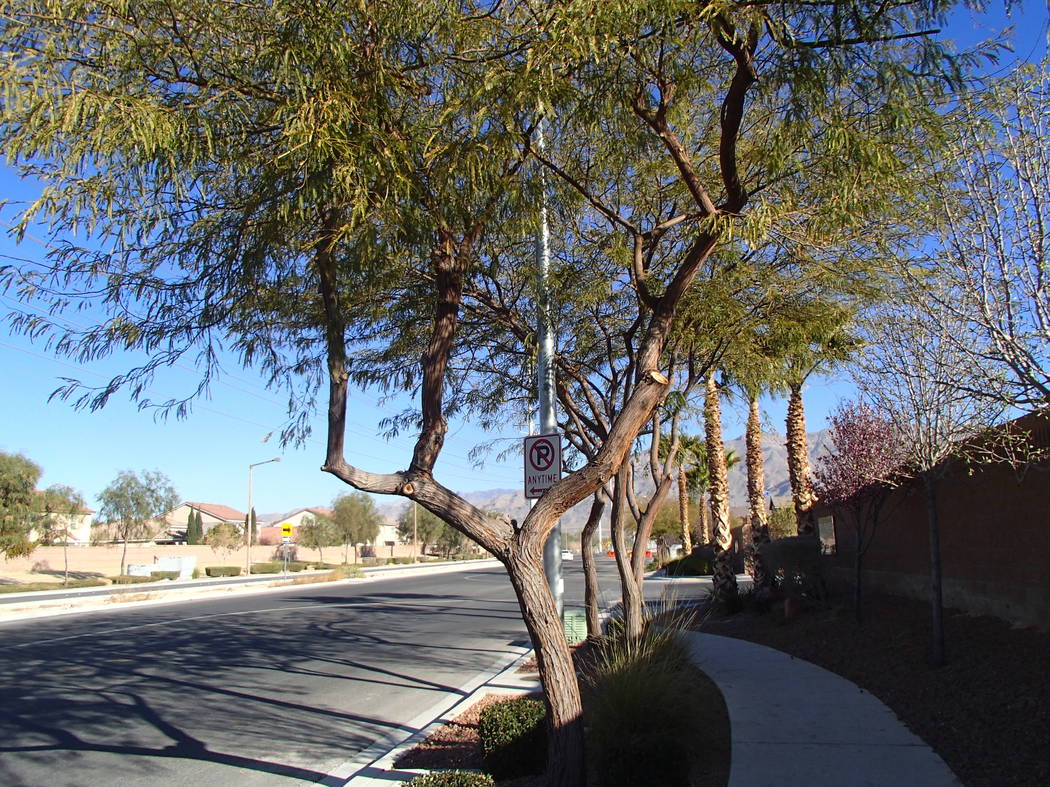Leaf-mining insect creates serpentine pattern on leaf

Q: In my morning walk around the garden, I found an unusual pattern on the leaves of my Arabian jasmine. Do you have any thoughts on what might have caused this?
A: This meandering or serpentine damage is by a leaf-mining insect. The damage is from one stage in the lifecycle of a fly that entomologists conveniently call the “serpentine leaf miner.”
Flies have four stages in their lifecycle: the adult fly, the egg, the maggot and the pupa that turns into the adult fly. The leaf damage that we notice is caused by leaf tunneling of the maggot stage.
The serpentine leaf miner punctures leaf surfaces where it lays its eggs. The egg is inserted inside the leaf, just under the outer layer or epidermis. This tiny maggot hatches inside the leaf in about four days and tunnels between the upper and lower surfaces of the leaf, where it feeds in a serpentine or snake-like pattern.
If you hold the leaf toward the light, you will see these serpentine patterns are tunnels created by the maggot. The second thing you notice is that this tunnel gets slightly wider from one end to the other; the tunnel is narrow where the egg is laid and gets bigger as the maggot meanders inside the leaf, feeding as it goes.
If you spot this damage and remove the leaf early enough, hold it to the light, and the maggot will still be inside the leaf. Leaf removal and immediate disposal as soon as the damage appears is an effective, nonchemical control option.
Whether to control this pest or not depends on the value of the damage it creates. Leaf miners also attack leafy green vegetables such as lettuce and spinach. Little or no damage is tolerated in leafy green vegetables because it’s food. But in the case of ornamentals like jasmine and garden roses, light damage might be tolerated before control options are considered.
Close relatives of this leaf miner tunnel into the leaves of citrus, vegetables, fruit trees and a variety of ornamentals, including weeds. For this reason, weed control can be an effective control measure around vegetables.
Methods of control include removing leaves as they become infested, insect netting or row covers over leafy greens and tolerance of the damage. Leaf removal and disposal when damage is seen can be an effective way of preventing an escalation in damage. Pesticides are available and may be used to prevent leaf miners in food crops.
Q: I discovered some white things on my grape leaves where they are connected to the branch of the trunk. The plant is only in its second year, bought from a local nursery last year. The leaves are green, but the vine does not grow. Please let me know what I should do.
A: The picture you sent was not clear. But what I could see looked like nothing I had seen here before on grapes. Grapes, both wine and table grapes, are being grown more and more in the Las Vegas Valley. It’s only a matter of time before pest problems in grape growing areas will become our problems as well. Some of these problems can devastate grapes.
The first thing I noticed on the leaves of your grape plant were shiny leaves. The upper surface of the leaves was shiny and sticky to the touch. It was attracting ants and bees. This is from insects that entomologists call “piercing and sucking.”
I pushed these leaves aside and found mealy bugs. This was a new insect for me on grapes grown in the Las Vegas Valley.
Piercing and sucking insects (aphids are in this group) damage the plant to get at plant juices that are full of sugar. These insects feed and defecate a concentrated, sugary residue that lands on the leaves. This sugary stuff is what attracts the bees and ants.
A control strategy, one that doesn’t involve spraying chemicals on the plants, is controlling the ants. Ants like piercing and sucking insects because of the sugar. They will move young insects to uninfested locations to increase their supply of sugary honeydew. Controlling ants reduces the spread of these insects to new locations.
Soap and water sprays applied directly to mealy bugs and other piercing, sucking insects will kill them. There is no poisonous residue left behind, so it should be repeated every three or four days until the problem is under control.
Q: Do you have any ideas on how to stop the flowers produced by mesquite trees? For the past two years, mine seems to have gone crazy producing the little yellow flowers that create a constant scum of yellow on my pool all summer long. This mesquite has 1.5-inch-long spines on new growth together with the leaves.
A: The tree sounds like a native mesquite, perhaps the honey mesquite. This tree is native to our desert Southwest, a North American native plant.
Production of fruit by olives and pods in mesquite can be controlled by spraying the tree when flowers are open. The flowers must be present and open for the spray to cause the fruit to abort.
So, the timing of the spray is critical for success. Chemicals such as Florel and Olive Stop are used. But sprays to prevent flowering are more difficult to find and apply.
Under desert conditions of limited rain, flowers are produced only in the spring when temperatures warm up. If the soil has water in it, there will be lots of flowers. If the soil is dry, flowering is sparse. If this tree is watered freely, then it is possible it can produce flowers in waves all summer long with each flush of growth.
Desert plants, such as this mesquite, are opportunists; they take advantage of water when it is present and restrict growth and flowering when water is not available. In other words, growth of all kinds, including flowering, is tied directly to irrigation.
Manage its growth and flowering by managing its supply of water. Water less often but with lots of water when you do water. Give it water in the spring, so it can grow and flower, and then restrict water the rest of its growing season.
This restriction of water will curtail its growth and flowering to once a year. At least then the yellow scum needs to be cleaned out of your pool for only three or four weeks each year.
Q: I purchased a plumcot fruit tree years ago for my home in New Jersey. I got great-tasting, sweet plumcots in early July every year. I never thought it could grow here. Yesterday, I was reading in the real estate section that a house for sale had a plumcot on its grounds. Will they grow here, or is it just that particular location?
A: The plumcot is a man-made hybrid between a plum and apricot. Other hybrids between these two fruit trees, apriums and pluots, also exist. These types of hybrids don’t occur in nature and are not GMOs but developed the old-fashioned way through plant breeding.
Our climate is a good climate for growing both plums and apricots, as well as hybrids such as plumcots. In fact, our desert climate is better for growing these types of fruit than the climate in New Jersey. Our intense sunlight and high temperatures help develop high sugar content and good flavor.
Pick a location in the yard that has plenty of sun but away from walls that produce a lot of radiated heat or reflected light. Dig a wide planting hole and mix a good quality compost with this soil when planting.
Add water to the hole as you are planting to help settle the soil and stake the tree for the first growing season. Cover the soil with a 4-inch layer of wood chips after planting. These dissolve into the soil where there is water and continue to improve it in the years to come.
Bob Morris is a horticulture expert and professor emeritus of the University of Nevada, Las Vegas. Visit his blog at xtremehorticulture.blogspot.com. Send questions to Extremehort@aol.com.



















